My question would be “Why wouldn’t you?” If you’ve bought a piece of artwork it’s obviously had an affect on you, enough to invest your hard earned cash in it. If you like it that much you should enjoy it for as long as possible. Not only does mounting and framing visually enhance your treasured image, it protects it from environmental and physical damage. From an artist’s point of view it finishes the work, raising it a level, adding value which makes it far more saleable than unframed work.
The “framing package” protects artwork from a number of notorious enemies; technical developments in framing materials and adopting good framing techniques means that the life of your work can be prolonged by years. However there are six main enemies of artwork: light, moisture, insects, airborne pollutants, heat and physical damage.
So how damaging can each of these be, and how does framing help?
Light
Light is possibly the most common source of damage to paper and textile based art. It destroys the cellulose in paper resulting in fading, embrittlement, and discolouration. This damage can be made worse by oxygen in the air and impurities in the base medium. Papers containing lignin and manufacturing additives yellow with exposure to light. Fabric and textile based art is particularly prone to fading and if kept in unfavourable conditions the outcome can be devastating.
Ultraviolet (UV) radiation is the most destructive component of light. It represents only 5% of visible light, but causes 90% of damage. The major source of UV is natural daylight and fluorescent lighting, and contrary to the belief of many UV light is present every day and everywhere. Be it summer, winter, sunny, rainy, north, south, east or west facing, it strikes and bounces from one surface to another. It’s ironic, that which allows us to see our artwork, is its enemy.
There are a few things you can do to slow the rate of damage. Never hang art in direct sunlight or too close to a fluorescent light source. If sunlight is likely to fall directly on your artwork try to relocate it, or consider having it glazed with one of the specialist UV filtering products. UV control window film provides an additional level of protection and is a small price to pay to protect your investment.
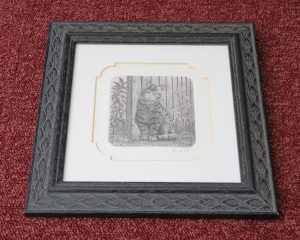
Mounted and framed etching. Yellowing of the bevel is showing signs of the mount becoming acidic.

Mount removed revealing acid damage, caused by acids leaching from the mount into the surface of the artwork.
Moisture
Moisture turns paper acidic due to a chemical reaction with elements in the paper itself, destroying it and the artwork. Paper absorbs moisture and will expand and contract as a result of changes in relative humidity and temperature. Framing artwork reduces the impact of excessive atmospheric changes and pollutants which may result in mould growth. Known as “foxing” it appears on paper as dull discolouring spots, and some mediums are more susceptible than others. Textiles suffering from mould develop a musty smell and a surface growth, but taking simple precautions can substantially reduce the likelihood of mould forming.
- Keep relative humidity below 65%.
- Don’t display pictures in damp situations, such as kitchens, bathrooms, basements or on cold external walls.
- Clean frames regularly, dust traps moisture and contains airborne mould spores.
- Encourage good air circulation both behind and within the frame. Use ‘bumpers’ on the back of the lower two corners, to hold the frame away from the wall. Mounts or spacers used during framing prevents the artwork coming in contact with the cold surface of the glass, preventing image transfer and condensation. Improved air circulation within the framing package equalises the humidity across the surface of the work.
- Avoid leaving pictures in closed unventilated rooms for long periods. When storing, good air circulation is key so raise the work off the floor.
- Have infected works professionally treated to kill mould, then rectify the conditions that caused it in the first place. However take care, any spores remaining can lay dormant for years and be reactivated when the conditions are right.
Insects & Airborne Pollutants
The most common source of insect damage to paper based art is from silverfish, and woodworm. However, paper isn’t the only option on the menu for woodworm, which will munch anything made of cellulose, and will stop at nothing to get to its delicacy, flour paste and glue size. Clothes moth and carpet beetle are the main enemies of textiles. Cockroaches tuck in to parchment, paper, leather, fabrics, and anything containing sugar. Ensuring the back of the framing package is fully sealed keeps out insects, dust and airborne pollutants and helps to maintain a stable environment within the frame.
Heat
High temperatures accelerate the deterioration of art, so avoid displaying it directly over radiators and all other heat sources. Equally, excessive variations in temperature should be avoided so where possible avoid hanging artwork on the chimney breast or cold external walls.
Physical Damage
Being completely enclosed behind glass within the framing package artwork is protected from knocks, nicks and abrasion. In extreme circumstances such as fire or flood, protection has been known to prevent total destruction.
How does framing enhance your artwork?
There are three components which have the major impact on work being presented, the mount, the frame and the glass.
The mount has two main functions, to present your work and to protect it from the glass; it’s used to create space allowing the image room to “breathe” in both a practical and aesthetic sense. There are no hard and fast rules about the size of the mount and although you will often hear framers referring to “over or under” mounting it’s really a matter of personal preference, but the work should look balanced. Double, triple or “fancy” mounts add importance to a smaller piece of work; equally a large frame can make a small picture look amazing. Float mounting is a great way to present a piece of work when the edge is part of its character such as papyrus, a piece of fabric or handmade paper. Keeping the edges visible enhances unique qualities of this kind of work.
Ensuring the mount works with the frame highlights subtleties of colour within the artwork and creates a harmonious presentation. A well-chosen frame will enhance an image enormously; conversely a badly chosen frame can ruin a piece of work, render it unimportant and substantially affect its perceived value. Considering the image provides clues to suggest the style of frame, and attention to detail such as matching the frame to the right historical period respectfully lifts the work from average to stunning.
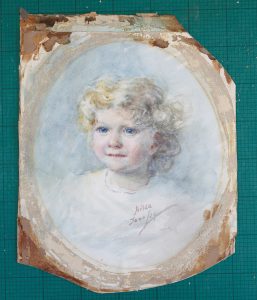
Unframed watercolour.
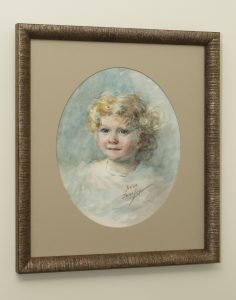
Watercolour mounted, framed and beautifully presented. Simple, stylish, enhancing and protecting the work.
Allow the image to dictate the colour and style of presentation. It isn’t advisable to mount and frame artwork in isolation to suit your décor as it may not be the best solution for the artwork itself. Try not to choose a “red” painting for a “pink” room, choose a piece of work that suits your interior, the presentation will then compliment your space. Alternatively allow the artwork to influence how you decorate your room.
Finally the glass, here technology has made a major leap forward. For years picture framers used good old 2mm float glass, which is great, but it has its limitations. For example it’s very reflective, so you see your own reflection before you see the image. It has a green cast which can affect the colour of the artwork, and it provides minimal UV protection, just 50%, so your work is still vulnerable. Compare this with extra clear museum quality glass which provides 96% light transmission, a superb 99% UV filtration and less than 1% reflection. The glass is virtually invisible, which is why I’m constantly polishing fingerprints off my display selector, because customers just don’t believe there is a piece of glass there; but it goes to prove that you see the image before you notice the glass. Admittedly it is the glass of choice for valuable work and it comes at a cost, but there is a host of alternative glazing options between standard and museum, depending on your priorities.
I love presenting work beautifully, so if I can help, I’m just a phone call away.



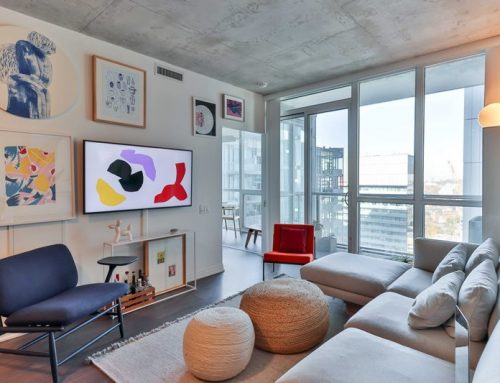


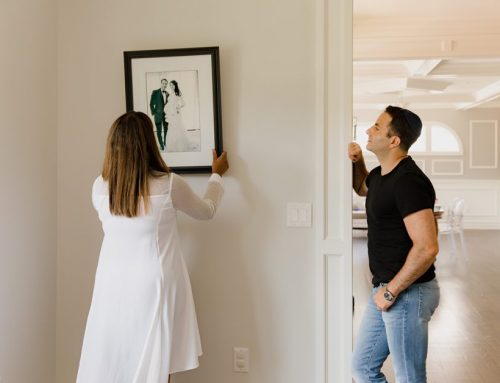

Leave A Comment